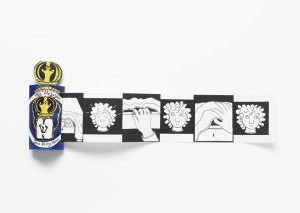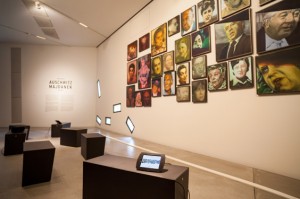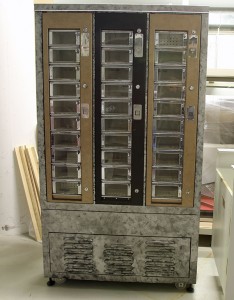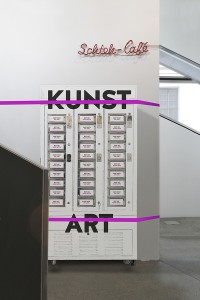Since the end of August visitors to the permanent exhibition have been able to purchase small artworks from an ‘art vending machine.’ The artworks have been created by Jewish artists living and working in Berlin.

Paper mezuzah with pull-out comic strip by Zara Verity Morris
© Jewish Museum Berlin, photo: Jens Ziehe
Today we present one of the artists: Zara Verity Morris from London. Morris is currently studying for her Masters degree at the “Institute for Art in Context,” at the Berlin University of the Arts. For the art vending machine she has created a comic strip called “The Mezuzah” on a pull-out paper scroll. (A mezuzah is a small case, which is attached to the door posts of Jewish households. Inside is a handwritten parchment scroll with the Hebrew prayer “Shema Yisrael” (“Hear O Israel”).
Christiane Bauer: Zara, can you for starters briefly explain to me why you produced this particular object for the art vending machine?
Zara Verity Morris: I found it an interesting challenge to play with the limited space of the art vending machine, and wanted to make something that could be unfolded once it has been taken out. The long paper roll was inspired by the formal connection between the Torah and a mezuzah.
When I was a young child, I found a few mezuzot in a drawer in varying conditions. A few had open cases. I was surprised to discover a paper scroll lying inside one of them with Hebrew writing on it. I was excited, and thought it was like a toy Torah. As a child, one of my favourite parts of being at a service at synagogue was the heavy Torah being ‘undressed’ by two people; getting its velvet cover and decorations taken off to reveal the plain paper scroll underneath. I decided to turn these childhood memories into a comic.
How does “The Mezuzah” fit into your previous work? → continue reading

Area on the Majdanek Trial in the permanent exhibition
© Jewish Museum Berlin, photo: Alexander Zuckrow
Forty-four portraits have been mounted in the permanent exhibition over the last few weeks. They are a series of paintings by Minka Hauschild, called “Majdanek Trial Portraits,” and they show the participants of the Majdanek Trial, that took place at the regional court in Dusseldorf from 26 November 1975 until 30 June 1981. Standing in front of the wall of portraits, viewers are left to wonder: “Who is who, here?” The paintings themselves don’t reveal whether the subject was a former prisoner or an SS officer. Some portraits are realistic, but others seem distorted or blurred to the point of being unrecognizable. All of the people portrayed appear to have been damaged in some way. The portraits are deeply disturbing.
Our visitors can find out on iPads lying on the benches nearby whether a given painting depicts a judge, a lawyer for the defense, a witness, or a defendant. Each individual’s role in the Majdanek trial is described here and insight is provided into their biography as well as – where the sources permit – their own perception of the proceedings. → continue reading

This is what the vending machine looked like originally.
© Jewish Museum Berlin, photo: Gelia Eisert
Usually a museum is a place where you can contemplate art from a safe distance. Today, with the mounting of our Art Vending Machine in our permanent exhibition, that will change: now you can put 4 euros in the coin slot, and own a piece of art from the museum!
If you’re imagining a high-tech machine that produces art, when you read the words “Art Vending Machine,” or something like a soda machine, where you can pick and choose from a selection, you’re on the wrong track. Our Art Vending Machine has a supply of small-scale artworks that were created by artists especially for it.
Since a device of this kind isn’t commercially available, I bid online for an old vending machine from the 1970s. I found one in a sports center in the Rhineland-Palatinate region of Germany and had it transported to us from there.

After its modification, the vending machine should look like this.
© Design: Hanno Dannenfeldt
Following the machine’s arrival, the graphic designer Hanno Dannenfeldt worked on a concept for reconfiguring it, since it’s meant to be not only a container for artworks tucked into all the little shelves, but itself part of the exhibition. The design, called “Hanging,” dresses the automat in a simple white coat of paint with an eye-catching black inscription. It’s strung up on the wall with pink slackline cables.
The next steps of this procedure raised some unusual questions for me as a museum employee: → continue reading



